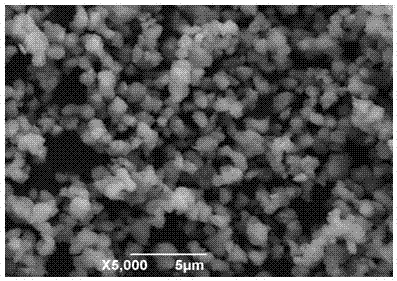Preparation method of wide potential window negative electrode material of lithium ion battery
A technology for lithium-ion batteries and negative electrode materials, applied in battery electrodes, circuits, electrical components, etc., can solve problems such as high cost, complex synthesis methods and routes, and achieve high reproducibility, reduce actual costs, and stabilize cycle life Effect
- Summary
- Abstract
- Description
- Claims
- Application Information
AI Technical Summary
Problems solved by technology
Method used
Image
Examples
Embodiment 1
[0022] Embodiment 1: with 0.22 mol lithium carbonate, 0.495 mol TiO 2 (Anatase type) and 0.005 mol lanthanum nitrate were mixed, and then put into a ball mill for 8 h to make it evenly mixed, and then put the final mixture into a muffle furnace, reacted at 850°C for 24 h, and then cooled naturally to room temperature, that is Li 4 Ti 4.95 La 0.05 o 12 . X-ray powder diffraction analysis indicated that the resulting Li 4 Ti 4.95 La 0.05 o 12 There are a few impurity peaks, and the crystallinity is high. According to scanning electron microscope analysis, the particle size of the obtained product is uniform, and the particle size is 1-2 μm. The resulting product was used as an electrode material and assembled into an experimental button lithium-ion battery in an argon-filled glove box. C The rate of charge and discharge cycle between 0-2.5 V, Li 4 Ti 4.95 La 0.05 o 12 The first discharge capacity is 243.9 mAh·g -1 , the second discharge capacity is 213.6 mAh·g -1...
Embodiment 2
[0023] Embodiment 2: with 0.23mol lithium carbonate, 0.49mol TiO 2 (Anatase type) and 0.01 mol lanthanum nitrate were mixed, and then put into a ball mill for 6 hours to make it evenly mixed, and then put the final mixture into a muffle furnace, reacted at 850°C for 18 hours, and then cooled naturally to room temperature , that is, Li 4 Ti 4.9 La 0.1 o 12 . X-ray powder diffraction analysis indicated that the resulting Li 4 Ti 4.9 La 0.1 o 12 Contains a small amount of Li 3x La 2 / 3?x TiO 3 Impurities. According to scanning electron microscope analysis, the particle size of the obtained product is uniform, and the particle size is 1-2 μm. The resulting product was used as an electrode material and assembled into an experimental button lithium-ion battery in an argon-filled glove box.C The rate of charge and discharge cycles between 0-2.5V, Li 4 Ti 4.9 La 0.1 o 12 The first discharge capacity is 235.1 mAh·g -1 , the second discharge capacity is 205.6 mAh g -1 ,...
Embodiment 3
[0024] Embodiment 3: with 0.4 mol lithium acetate, 0.495 mol TiO 2 (amorphous type), 0.0025 mol lanthanum trioxide mixed, and then put into a ball mill for ball milling for 12 hours to make it evenly mixed, then put the final mixture into a muffle furnace, react at 950°C for 12 hours, and then cool naturally to At room temperature, Li 4 Ti 4.95 La 0.05 o 12 . The resulting product was used as an electrode material and assembled into an experimental button lithium-ion battery in an argon-filled glove box. C The rate of charge and discharge cycles between 0-2.5V, Li 4 Ti 4.95 La 0.05 o 12 The first discharge capacity is 240.1mAh·g -1 , the second discharge capacity is 211.3 mAh·g -1 , with a reversible capacity of 201.8 mAh g after 100 cycles -1 , Li 4 Ti 4.95 La 0.05 o 12 Excellent rate performance over a wide potential window is shown.
PUM
| Property | Measurement | Unit |
|---|---|---|
| particle diameter | aaaaa | aaaaa |
Abstract
Description
Claims
Application Information
 Login to View More
Login to View More - R&D
- Intellectual Property
- Life Sciences
- Materials
- Tech Scout
- Unparalleled Data Quality
- Higher Quality Content
- 60% Fewer Hallucinations
Browse by: Latest US Patents, China's latest patents, Technical Efficacy Thesaurus, Application Domain, Technology Topic, Popular Technical Reports.
© 2025 PatSnap. All rights reserved.Legal|Privacy policy|Modern Slavery Act Transparency Statement|Sitemap|About US| Contact US: help@patsnap.com



